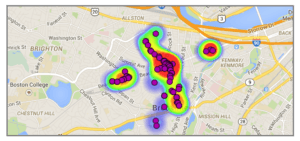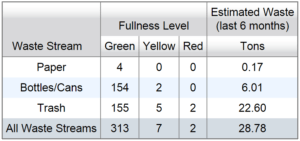Bigbelly Trash Cans: They know a lot more than you think

Bigbelly has turned city trash into a treasure trove of data.
Bigbelly has brought technology to the forefront of a product that couldn’t seem any more disconnected: trash cans. The company and its fleet of smart trash and recycling cans have completely changed how cities, universities, and hospitals manage and budget their waste collection processes. Just thirteen years after its original design, Bigbelly has supplied 1,500 cities in 47 countries around the world with trash/recycling bins that have helped reduce customer waste management costs by 70-80% [1].
In 2003, while living in Boston, Bigbelly founder, Jim Poss, grew fed up with the sight of overflowing trash cans and idle trash trucks burning billions of gallons of diesel fuel per year. In response, Poss designed a solar powered trash compactor with five times the carrying capacity of a traditional trash can [2][3]. Poss’ value proposition was both simple and effective. His trash cans offered city’s the opportunity to significantly reduce the frequency (and cost) of its trash collections operations. Soon enough, cities such as Boston, Baltimore, Cincinnati, New York, Vancouver, and Chicago began to buy in. That said, Bigbelly’s business potential was limited. Its product was not much more than a superior standalone city trash can that cost significantly more than traditional trash cans.
That all changed six years later when Bigbelly began installing cellular modems into its bins. These modems would connect waste management teams to their entire collection of Bigbelly trash/recycling cans [4]. With the old Bigbelly models, a red light would blink on the trash can when it reached capacity, but only people who physically walked by the trash cans would know the bins were full. As a result, cities still spent plenty of money paying employees to drive around and visibly inspect all trash cans. Now with wireless notification, however, waste management teams didn’t have to go anywhere; the trash cans would simply notify them wirelessly and waste management would dispatch collection trucks when necessary.
In 2011, Bigbelly inserted itself even further into the waste management value stream with its “Smart Grid for Waste and Recycling.” Also referred to as the CLEAN console, it provided waste managers with access to real-time and historical data on fullness levels, rate of volume change, and collections. [5]
The Bigbelly CLEAN console armed waste managers with the capability to quickly respond to current issues as well as strategically plan for future requirements. Managers now had all the tools necessary to map out optimal locations for trash cans and design collection routes that maximized trash pick-up. Not only that, but Bigbelly could now deliver software functionality, diagnostics, upgrades, and proactive maintenance upgrades remotely from a network command center [6]. Bigbelly was no longer a trash can provider, it was a waste management service provider. It even required customers to start paying an additional service fee. Leila Dillon, VP of Marketing, said, “[E]very single customer going forward no longer thought of this as buying trash stations, but instead about entering into a partnership with Bigbelly.” [7]
Bigbelly’s expanding value proposition has led to incredible gains in operational and cost efficiency. Philadelphia, for example, has reduced its trash collections from seventeen times per week to just three, saving one million dollars per year in fuel and operational costs. [8]
What else is there to do??
The company hasn’t stopped pushing digital transformation. For the past couple of years, it’s been exploring the idea of potentially turning its bins into Wi-Fi hotspots for consumer use and is currently testing these capabilities in certain areas of New York City [9]. If Bigbelly can actually bring Wi‑Fi hotspots to its trash cans, it’s not hard to imagine the company’s appetite growing well beyond that of garbage collection data. Bigbelly could start collecting a huge range of city data. In early 2015, Bigbelly CEO Jack Kutner said that “the possibilities for data collection via sensors on the machines are endless: from pedestrian traffic to pollution and radiation detection.” [9] Going forward, it’ll be very interesting to see how big of a role Kutner wants to play in city data analytics. The obvious concern is that if Bigbelly moves further into big data collection, hackers will start to notice. Depending on the sensitivity of the new data, I question whether Bigbelly has the digital infrastructure necessary to protect itself and its clients from cyber‑attacks. All that said, whatever Bigbelly’s digital future holds, it’s amazing to think that we’re even discussing it. We’re talking about trash cans here people.
Word Count: 737
[1] PR Newswire, “Bigbelly Receives ‘Acceptance Letters’ from Universities and Colleges across the Country.” http://www.prnewswire.com/news-releases/bigbelly-receives-acceptance-letters-from-universities-and-colleges-across-the-country-300040594.html
[2] Babson Magazine, “Green Trash: How do you make a buck and save the earth? One Dumpster at a time.” http://www.babson.edu/news-events/babson-magazine/winter-2013/Pages/green-trash.aspx
[3] Waste Management World, “Converting RCVs to Natural Gas Fuel.” https://waste-management-world.com/a/converting-rcvs-to-natural-gas-fuel
[4] IoT Journal, “How Bigbelly Evolved from a Waste-Management Firm to an IoT Company.” http://www.iotjournal.com/articles/view?12628/
[5] Bigbelly.com, “Visibility & Accountability.” http://bigbelly.com/solutions/clean/
[6] Business Wire, “Bigbelly Solar Unveils Smart Grid Waste Recycling.” http://www.businesswire.com/news/home/20110926006017/en/BigBelly-Solar-Unveils-Smart-Grid-Waste-RecyclingTM
[7] WasteDive, “Bigbelly launches Connect: We’re changing our whole business model.” http://www.wastedive.com/news/bigbelly-launches-connect-were-changing-our-whole-business-model/406613/
[8] The Huffington Post, “These 4 Major Cities are Using Sweet New Technology to Become Smarter and Greener.” http://www.huffingtonpost.com/2015/09/16/smart-cities-green-infrastructure_n_6977504.html
[9] Upstart Business Journal, “Is that just a trash can, or might it also be a wi-fi hotspot?” http://upstart.bizjournals.com/companies/innovation/2015/01/23/bigbelly-solar-power-trash-cans-wifi-hotspot.html?ana=e_ubj&u=16632873754f4bfbf3a78dab89d04a&t=1422154358&page=all






Casey, Thank you writing this post. I am sure we have all noticed these “sophisticated” looking garbage cans since we have arrived here in Boston. I personally didn’t realize that these cans had the ability to enhance route density for municipalities trash collections. With the right predictive analytics you can see how valuable this technology can be in reducing costs and emissions. In addition, I agree, I am not sure I see the utility in the company expanding into addition data collection activities but I do wonder if Bigbelly can use its existing technology and algorithm in other logistically intensive business (ATM loading, last mile delivery, etc.) that historically have excess waste in their operations.
Great post Casey!! What a crazy topic. I think this proves to be an excellent example of how digital transformation impacts nearly every aspect of our lives, even trashcans… I look forward to hearing about how Big Belly continues to evolve and what steps they’ll take next!! The mention of possibly measuring pedestrian foot traffic or radiation detection sounds like they could offer additional beneficial services and information to the cities with which they have partnered!! I wonder where they will go next.
Very cool, Casey!
A couple of things I wonder:
1) What are the upfront costs of setting up BigBelly trash vs. traditional trash cans, and how long does it take to make up for that upfront cost.
2) I know that a few of them have a recycling component as well – but that they don’t compress garbage in the same way. I thus wonder whether the recycling requires more frequent pickup, and so counteracts the benefits mentioned above. And if they do, what would actually be more helpful to the environment – optimized and less frequent pickup as described in your post or better recycling practices?
This is such an interesting post on the smart trash cans, and I started to realize that we have some on the HBS campus! It is fascinating to see how small and simple digital sensor with wireless connections can revolutionize a traditional practice and drive efficiency! Instead of BigBelly expand beyond the waste management industry, I am wondering if it can go deeper to solve more issues within the same industry. In particular, how can smart trash cans provide information to help drive people’s recycling habits. A common problem is that many people do not know what items count as recycles versus what do not. And the different standards and systems employed by different cities cause further confusion. I am wondering if smart trash cans can work with government to develop a “barcode” on the cycled items’ packaging and incorporate the identification systems on the trash cans. People can simply scan the barcode to see if the recycles will be admitted or not. In this way, it can generate possibilities of more specific recycled categories, save a lot of sorting efforts on the government end, and educate people more on recycling knowledge.
Casey- this was so interesting! Thank you for sharing this post!
What Big Belly is doing in the waste management industry is truly next-level. I particularly enjoyed understanding how they’re using smart modems in their trash cans to hone data. I wonder if there is also an opportunity to better educate consumers as a result of the data collected. For instance, in particular parts of a city, if customers are frequently recycling materials that shouldn’t be recycled, perhaps Big Belly can run public campaigns to educate consumers on what goes where. Or if customers are frequently throwing away clothing items or other items that can be donated, suggesting the locations of nearby Goodwill or Salvation Army drop boxes might allow Big Belly to help customers better society. This data is very powerful and can have a ton of impact on cities as a whole.
Thanks again for sharing Casey- this was great!
I remember back in middle school we were required to draw a still-image of an object, and I chose a trashcan to be edgy. I’m glad that was actually foresight into how much power trashcans would hold in the future!
On a serious note, I agree with Olivia that the next step I see for “smart” trashcans is figuring out what is recyclable vs. not. I can imagine a future where there is a single receptacle, and the trashcan can determine whether or not any item that is inserted is recyclable or not. I’m not sure how much money goes into trashcan R&D to develop something like that, but I know prototypes have been developed in hackathons.
http://phys.org/news/2013-09-smart-recycle-bin-record-breaking-mhacks.html